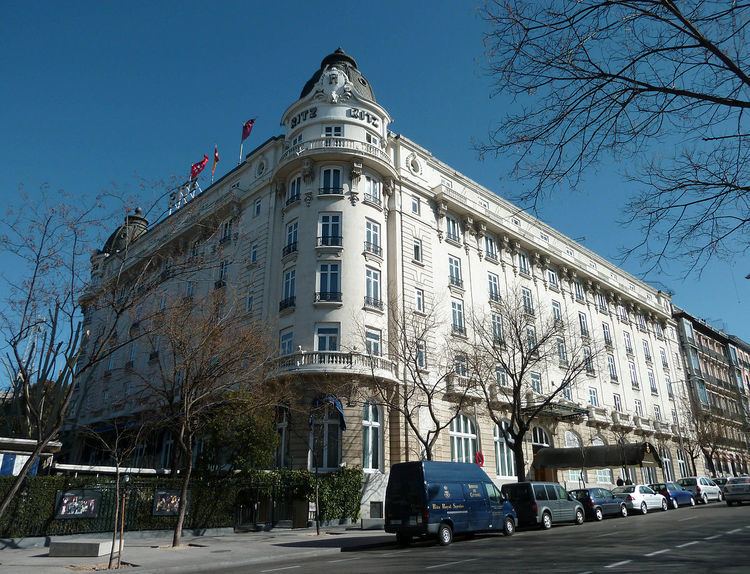Number of rooms 167 | ||
 | ||
Location Plaza de la Lealtad 5, 28014, Madrid, Spain Affiliation The Leading Hotels of the World | ||
Hotel Ritz is a belle époque palace hotel in Madrid’s “Golden Triangle” of culture. It is located directly opposite the Museo del Prado and close by other major galleries including the Thyssen-Bornemisza Museum and Museo Nacional Centro de Arte Reina Sofia. Also nearby are the Buen Retiro Park and Botanical Gardens. The hotel’s façade is a listed national monument and it sits in gardens with a terrace restaurant.
Contents
It is a five star luxury hotel located in Madrid, Spain at No. 5 in the Plaza de la Lealtad, Retiro district, next to the Prado Museum and opposite the Thyssen-Bornemisza Museum. It celebrated its 100-year anniversary in October 2010 and was renovated in 2013. It was built by King Alfonso XIII in 1910 to model a royalty hotel.
History
The hotel was built at the request of King Alfonso XIII of Spain and opened on Sunday October 2, 1910. King Alfonso XIII had returned from a European tour during which he realized that the Spanish Court lacked a hotel with enough dignity for European royalty and other top rank visitors. His idea was to build a Madrid hotel similar to the Ritz Hotels in London and Paris. The king himself provided part of the capital. Famous hotelier César Ritz was engaged to lead the project.
The building was designed by French architect Charles Mewes and Spanish architect Luis de Landecho. It became one of the first in Madrid to use reinforced concrete in its construction. The most famous Spanish and foreign companies of the time contributed to the decoration of its rooms. Carpets were woven to order at Spain’s Royal Tapestry Factory, linens were commissioned from Ireland and crockery and cutlery arrived from England.
The hotel was built at the behest of King Alfonso XIII who, returning from a tour of Europe, realized that the Spanish Court lacked a hotel with enough pomp for European royalty and other illustrious visitors. His idea was for Madrid to have such a hotel to equal the likes of The Ritz London Hotel and Hôtel Ritz Paris. His own marriage to Victoria Eugenie of Battenberg was another excuse to give Madrid a luxury hotel, the first in the Spanish capital. The king himself contributed part of the capital, along with other members of Madrid society, and he instructed the Ritz Development Company that it would be designed and built under the personal supervision of César Ritz. Although Ritz initially intended to be involved in the project, he was unable to do so because of depression. Although there was an expressed desire of Alfonso XIII supporting the hotel's construction, some of the politicians of the time showed strong opposition to the project, alleging that the projected height of the building was not permitted by zoning laws for this area. Eventually, however, the project was able to proceed.
The chosen site was once an area occupied by barracks belonging to the Hippodrome Circus and the gardens of the old Theatre Tivoli, and was formerly owned by Jardines del Buen Retiro de Madrid. The hotel's grand opening on 2 October 1910 was officiated by King Alfonso XIII in the company of ministers and representatives of the mayor of Madrid. The hotel quickly became one of the leaders of the social and cultural life of the capital. The first board was chaired by Luis de Cuadra y Raúl Marquis de Guadalmina. The first hotel manager was Antonio Mella, who had previously managed the Ritz Hotel in Paris and London. His wife helped him in hotel management taking over guest services and laundry rooms.
Previous owner Belmond sold the hotel to Mandarin Oriental and the Saudi-based Olayan Group in May 2015 for $148 Million. Mandarin Oriental announced plans to refurbish the hotel at a cost of $103 million by 2017.
Architecture and fittings
The building was designed in 1908 by French architect Charles Mewès and built in the period 1908-10 under the direction of Luis de Landecho. This was one of the first buildings in Madrid that used reinforced concrete in its construction, which was completed on 14 May 1910. Notable Spanish and foreign companies were hired to decorate the rooms. The carpets were woven in the Royal Tapestry Factory, linens was commissioned to Irish firms, the furniture was commissioned to Lissarraga y Sobrinos, and mirrors were by Pereantón. The china was by Limoges and cutlery was imported from The Goldsmiths.
Chronology
Guests
Throughout its history, many famous guests have stayed at the hotel, from Ernest Hemingway to Rainier III, Prince of Monaco and his wife Grace Kelly who celebrated their honeymoon in one of its suites. Others include Ava Gardner, Michelle Pfeiffer and Madonna.
